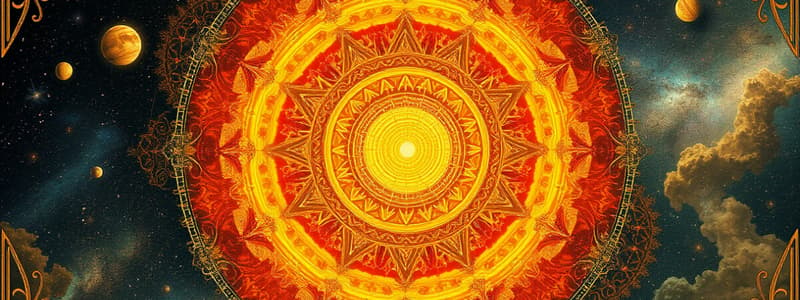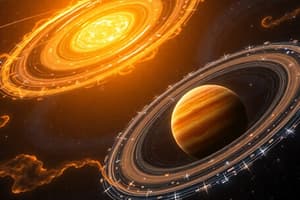Podcast
Questions and Answers
What is nucleosynthesis?
What is nucleosynthesis?
The formation of elements such as hydrogen and helium.
According to the Solar Nebular Theory, from what did the solar system originate?
According to the Solar Nebular Theory, from what did the solar system originate?
- A black hole
- A star
- A nebula (correct)
- A planet
What are the three major steps in the formation of the solar system?
What are the three major steps in the formation of the solar system?
Cloud collapse, formation of protoplanetary disk, and growth of planets.
What is a planetesimal?
What is a planetesimal?
The Tidal Theory states that the solar system formed as a result of a near collision between a passing star and the sun.
The Tidal Theory states that the solar system formed as a result of a near collision between a passing star and the sun.
Who proposed the Tidal Theory?
Who proposed the Tidal Theory?
What was one drawback of the Tidal Theory?
What was one drawback of the Tidal Theory?
What did the Capture Theory propose?
What did the Capture Theory propose?
What is the Modern Laplacian Theory?
What is the Modern Laplacian Theory?
What is one proposed fate of the universe regarding its expansion?
What is one proposed fate of the universe regarding its expansion?
Flashcards are hidden until you start studying
Study Notes
Theories of the Origin of the Solar System
- Solar Nebular Theory: The solar system formed from a nebula approximately 4.5 billion years ago, supported by the presence of hydrogen and helium.
- Nebula Definition: A nebula is a giant cloud of gas and dust in space, essential for the formation of stars and galaxies.
Major Steps in Solar System Formation
- Cloud Collapse: Triggered by a shockwave from a supernova or passing star; results in increased density and gravitational pull.
- Formation of Protoplanetary Disk: Metals and silicates exist closer to the sun; terrestrial planets (Mercury, Venus, Earth, Mars) form due to higher boiling points.
- Growth of Planets: Dust and grains accumulate to create clumps, which coalesce into planetesimals, eventually forming planets.
Proponents of Solar Nebular Theory
- Notable figures: Emanuel Swedenborg, Immanuel Kant, Pierre-Simon Laplace contributed to the development of this theory.
Drawbacks of the Nebular Theory
- Challenges include mutual repulsion of particles around Saturn and inconsistency with angular momentum laws, affecting the sun's expected spin rate.
- Rotation anomalies for Uranus and Venus contradicts the predictions of the theory.
Encounter Theory (Tidal Theory)
- Proposal: Planets formed from materials ejected from the sun during a close encounter with another celestial body.
- Introduced by James Jeans and Harold Jeffreys in 1918.
Drawbacks of the Tidal Theory
- Hot material from stars cannot contract to form planets, limiting its acceptance.
Planetesimal Theory
- This theory suggests that planets formed from solid particles due to the gravitational influence of a nearby passing star.
- Proposed by Thomas Chrowder Chamberlin, while mathematical support was provided by Forest Ray Moulton.
Drawbacks of the Planetesimal Theory
- Not widely accepted due to the inability of hot material from the sun to contract, and the disruption from passing stars preventing planet formation.
Capture Theory
- Suggests the sun captured materials from a passing star, which orbited and eventually formed planets through accretion.
Modern Laplacian Theory
- Proposed by Pierre-Simon Laplace in 1796, suggesting planets formed from a rotating nebula that cooled and collapsed into rings leading to planets.
- The modern version assumes solid dust grains create drag on the gas, contributing to the formation of the sun and planets.
Universe's Fate (Discussion Points)
- Speculation on whether the universe will continue to expand indefinitely or contract due to gravitational forces.
- Personal theories on solar system formation could include aspects of various proposed theories merged with personal insights.
Studying That Suits You
Use AI to generate personalized quizzes and flashcards to suit your learning preferences.




